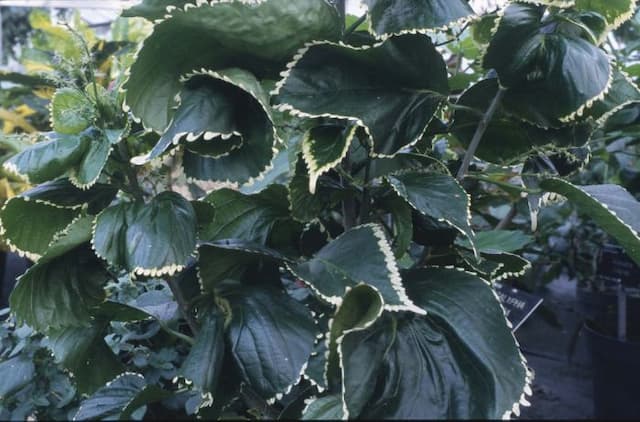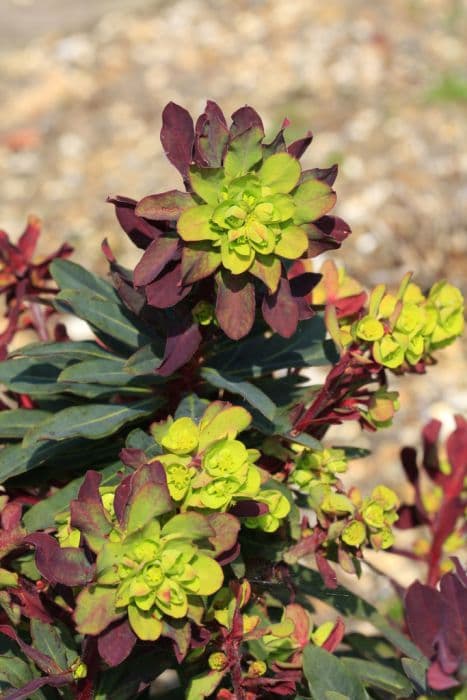Euphorbia epithymoides 'Major'

ABOUT
The Euphorbia epithymoides 'Major', commonly known as cushion spurge, is a striking perennial plant. It has a mounding form, with dense, compact foliage that makes it look like a cushion or a puffy cloud. The leaves are a vibrant, medium green color, and they are often oval-shaped with a slightly pointed tip. They are arranged in a spiral around the stem, giving the plant a full and lush appearance. During the spring, cushion spurge produces a breathtaking display of flowers, but what most people consider the flowers are actually bracts, which are modified leaves. These bracts are typically a bright, showy yellow that can look like a sea of gold from a distance. They provide a long-lasting color display that adds a burst of cheerfulness to any garden setting. The actual flowers of the cushion spurge are minute and not noticeable without closer inspection, as they are hidden within the yellow bracts. These plants are known for their ease of care and their ability to add a vibrant splash of color to garden landscapes. In the fall, the foliage may change to a reddish or purplish shade, adding to the plant's ornamental value throughout multiple seasons before it goes dormant for the winter.
About this plant
 Names
NamesFamily
Euphorbiaceae
Synonyms
Cushion Spurge, Polychrome Spurge
Common names
Euphorbia polychroma, Euphorbia polychroma 'Major'
 Toxicity
ToxicityTo humans
The most common common name of Euphorbia epithymoides 'Major' is cushion spurge. Cushion spurge contains toxic latex-like sap that can cause skin irritation and inflammation upon contact. If ingested, the sap can lead to severe pain in the mouth and throat, nausea, vomiting, and diarrhea. In some cases, it may cause swelling of the lips, tongue, and throat, which could lead to difficulty breathing or swallowing. Eye contact with the sap can result in irritation and even temporary blindness. Therefore, it is important to handle this plant with care and wash hands thoroughly after coming into contact with it.
To pets
Cushion spurge is also toxic to pets if ingested. Similar to humans, the latex-like sap of the plant can cause irritation and inflammation of the skin. If a pet chews on or ingests parts of the plant, it can lead to symptoms such as drooling, vomiting, and diarrhea. In severe cases, ingestion may cause more serious gastrointestinal issues and could potentially lead to an obstruction. Contact with the eyes can cause discomfort and inflammation, and in severe cases, temporary or permanent blindness. It is essential to keep this plant out of reach of pets and seek veterinary attention if ingestion or skin contact is suspected.
 Characteristics
CharacteristicsLife cycle
Perennials
Foliage type
Semi-deciduous
Color of leaves
Green
Flower color
Yellow
Height
1-2 feet (30-60 cm)
Spread
1-2 feet (30-60 cm)
Plant type
Herb
Hardiness zones
5
Native area
Europe
Benefits
 General Benefits
General Benefits- Easy to Grow: Euphorbia epithymoides 'Major', commonly known as Cushion Spurge, is a hardy perennial that is easy to care for and maintain.
- Drought Tolerant: Once established, Cushion Spurge is quite drought tolerant, making it an ideal choice for xeriscaping or low-water gardens.
- Spring Blooms: It produces vibrant yellow-green flowers in spring that add a bright splash of color to any garden.
- Deer Resistant: This plant is known to be resistant to deer, which makes it suitable for gardens in areas where deer are a common problem.
- Seasonal Interest: Provides visual interest in the garden throughout the seasons with its changing foliage and blooms.
- Low Maintenance: Cushion Spurge requires minimal care once established, which makes it perfect for beginner gardeners or those who prefer low-maintenance landscapes.
- Pest Resistant: It has few issues with pests, reducing the need for chemical treatments and making it a more environmentally friendly option.
- Attracts Pollinators: Its flowers attract bees and other beneficial insects, which are important for pollination and healthy gardens.
 Medical Properties
Medical PropertiesThis plant is not used for medical purposes.
 Air-purifying Qualities
Air-purifying QualitiesThis plant is not specifically known for air purifying qualities.
 Other Uses
Other Uses- Euphorbia epithymoides 'Major', commonly known as Spurge, can be used in floral arrangements, providing a vibrant yellow-green color and unique structure to bouquets.
- The milky sap of Spurge can be applied to wooden surfaces as a natural varnish, though it must be handled carefully due to its irritant properties.
- When dried, the seed pods of Spurge can be used for crafting, adding an interesting texture to handmade wreaths or decorative displays.
- The plant can be used in landscaping to prevent soil erosion on slopes due to its rooting system that helps to stabilize the ground.
- Spurge can act as a companion plant in the garden, its pungent sap may deter certain pests from more susceptible plants.
- The unique spherical shape of Spurge's foliage can be inspirational for artists and designers looking for organic forms in their work.
- Dried Spurge can be utilized as part of a natural dye process for fabrics, yielding varying shades of green and yellow depending on the mordant used.
- In educational settings, Spurge can be used to demonstrate plant growth habits and the lifecycle of a perennial to students.
- The Spurge plant can be used as a living mulch, providing the soil with organic matter as its leaves shed and decompose.
- During festive seasons, Spurge can contribute to "green" holiday decor, serving as a sustainable alternative to artificial ornaments.
Interesting Facts
 Feng Shui
Feng ShuiThe Spurge is not used in Feng Shui practice.
 Zodiac Sign Compitability
Zodiac Sign CompitabilityThe Spurge is not used in astrology practice.
 Plant Symbolism
Plant Symbolism- Resilience - Euphorbia epithymoides 'Major', commonly known as cushion spurge, is known for its hardiness and ability to thrive in various conditions, symbolizing the ability to withstand challenges and adapt.
- Renewal - With its bright yellow-green flowers that bloom in spring, cushion spurge represents new beginnings and the renewal of life, echoing the rebirth of nature after winter.
- Caution - The milky sap of cushion spurge can be an irritant to the skin and eyes, making it a symbol of caution and the need to handle certain situations with care.
- Protection - In some traditions, spurge plants were thought to ward off evil and provide protective qualities, so cushion spurge may be considered a symbol of safeguarding oneself or one’s home.
 Water
WaterCushion Spurge needs to be watered regularly but with moderation to prevent waterlogged soil, generally about one inch of water per week, either from rainfall or manual watering. During prolonged dry spells or hot weather, increase watering slightly to keep the soil consistently moist but not soggy. During winter, watering can be reduced substantially, as the plant is dormant and its water requirements are minimal. It's best to water the plant at the soil level to avoid wetting the foliage, which can lead to fungal diseases. Aim to provide about half a gallon of water per square foot every week during the active growing season.
 Light
LightCushion Spurge thrives in full sun to partial shade. The ideal spot for this plant is an area that receives at least 6 hours of direct sunlight. The plant can tolerate light shade, especially in the hot afternoon, but too much shade can result in leggy growth and reduced flowering. For optimal growth and flowering, position it in a location where it will receive morning sunlight and some partial afternoon shade, especially in regions with intensely hot summers.
 Temperature
TemperatureCushion Spurge is hardy and can tolerate a range of temperatures, enduring a minimum of -30 degrees Fahrenheit in winter to a maximum of around 90 degrees Fahrenheit in summer. The ideal growing temperatures for the Cushion Spurge are between 60 and 75 degrees Fahrenheit. It is crucial to avoid exposure to temperatures below the minimum range, as this can damage or kill the plant.
 Pruning
PruningPrune Cushion Spurge in late winter or early spring to remove any dead or damaged stems and promote fresh growth. It is also advised to cut back the plant after it has finished blooming to maintain its shape and prevent self-seeding, which can sometimes lead to excessive spreading. Typically, pruning this plant once a year is sufficient, and the best time to do it is when new growth begins to appear.
 Cleaning
CleaningAs needed
 Soil
SoilCushion spurge (Euphorbia epithymoides 'Major') thrives in well-draining soil enriched with organic matter. A soil mix consisting of equal parts garden soil, peat, and perlite or coarse sand can be ideal. The soil pH should be slightly acidic to neutral, ranging between 6.0 to 7.5.
 Repotting
RepottingCushion spurge typically does not require frequent repotting and can be done every 2-3 years. It's best to repot in the spring when the plant is emerging from dormancy.
 Humidity & Misting
Humidity & MistingCushion spurge prefers a moderate humidity environment but is quite adaptable and can tolerate dry air. It does not have specific high humidity requirements.
 Suitable locations
Suitable locationsIndoor
Place in bright, indirect light and water sparingly.
Outdoor
Plant in full sun to partial shade in well-drained soil.
Hardiness zone
4-8 USDA
 Life cycle
Life cycleThe Euphorbia epithymoides 'Major', commonly known as Cushion Spurge, begins its life as a seed, which germinates in early spring under appropriate temperature and moisture conditions. The seedling emerges and develops a root system and a rosette of leaves during its first growing season. As it enters its vegetative stage, it forms a cushion-like mound of foliage, and by the following spring, it starts producing bright yellow-green, showy bracts surrounding the small, inconspicuous flowers. After pollination, typically by insects, the plant develops small, three-lobed seed capsules that explosively release seeds when mature, usually in late spring or early summer. The Cushion Spurge is a perennial plant, meaning it will enter a period of dormancy in winter, dying back to the ground before regrowing from its rootstock the next season. This cycle repeats annually, with the plant potentially spreading through both seed dispersal and vegetative expansion over time.
 Propogation
PropogationPropogation time
Spring-Early Summer
Propogation: The most popular method of propagating Euphorbia epithymoides 'Major', commonly known as cushion spurge, is through division. Division should be carried out in early spring or fall when the plant is not in active growth. To propagate by division, one should carefully dig up the entire plant and gently separate the root mass into smaller sections, making sure each section has a portion of the root system and several shoots. These sections can then be immediately replanted in well-prepared soil, ensuring they are spaced about 12 inches (approximately 30 centimeters) apart to allow for adequate growth. It is important to wear gloves during this process as the sap of Euphorbia can be irritating to the skin. After planting, water the new divisions thoroughly to help establish them.



![Spurge [Blackbird]](/_next/image?url=https%3A%2F%2Fplants-admin.emdemapps.com%2Fimages%2Fplants%2F%2Fimages%2F604b535f37783.png&w=640&q=75)





